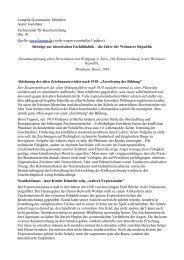Research in Visual Arts Education - The National Society for ...
Research in Visual Arts Education - The National Society for ...
Research in Visual Arts Education - The National Society for ...
You also want an ePaper? Increase the reach of your titles
YUMPU automatically turns print PDFs into web optimized ePapers that Google loves.
MEDIATED ACTION AND AESTHETIC LEARNING<br />
are <strong>in</strong>spired by “the methods of art”. “<strong>The</strong> radical aesthetics” of art – or<br />
rather of contemporary Western art – is described <strong>in</strong> terms such as open,<br />
question<strong>in</strong>g and critical:<br />
<strong>The</strong> strength of art is rather that curiosity and questions, contradictions and uncerta<strong>in</strong>ty<br />
may persist. (…) A radical aesthetics should not exclude what is fraught with conflict or<br />
unpredictable. It should challenge conventions and rout<strong>in</strong>es by mak<strong>in</strong>g familiar th<strong>in</strong>gs<br />
appear unfamiliar, shift<strong>in</strong>g perspectives and turn<strong>in</strong>g th<strong>in</strong>gs upside down. (Thavenius,<br />
2004, p. 120)<br />
Tomas Saar (2005), <strong>in</strong> an ethnographic study, uses a similar description of<br />
the potential power of art. He makes a dist<strong>in</strong>ction between a “strong” aesthetics,<br />
which challenges us to look at th<strong>in</strong>gs <strong>in</strong> new perspectives or notice<br />
their ambiguity, and a “weak” aesthetics, which is used to support, illustrate<br />
or embellish a given body of knowledge.<br />
Aesthetic education as mediated action<br />
In En kulturskola för alla [A Culture School <strong>for</strong> All; Marner & Örtegren,<br />
2003] and Möten & medier<strong>in</strong>gar [Meet<strong>in</strong>gs & Mediations; Marner, 2005],<br />
Anders Marner, together with Hans Örtegren, analyse issues <strong>in</strong> the Swedish<br />
discourse on aesthetic education. <strong>The</strong>y claim, like James Wertsch (1991),<br />
that human action typically employs “mediational means” such as tools<br />
and language, and that the mediation shapes the action <strong>in</strong> essential ways.<br />
Marner and Örtegren (2003) share the vision by Aul<strong>in</strong>-Gråhamn, Thavenius<br />
and others of the school as a seedbed <strong>for</strong> democracy. However, they criticise<br />
their colleagues <strong>for</strong><br />
… neglect<strong>in</strong>g the medium-specific competence <strong>in</strong> favour of a medium-neutral perspective.<br />
In the long run, this will impair ef<strong>for</strong>ts to implement aesthetic projects, s<strong>in</strong>ce students<br />
and teachers who already master the particular medium, will be the only ones to take the<br />
risk of enter<strong>in</strong>g <strong>in</strong>to a medium-specific dialogue (s. 78).<br />
Referr<strong>in</strong>g to Lev Vygotsky’s theory of creativity (Vygotskij, 1995), they reject<br />
the idea of a sovereign subject who freely expresses herself, rely<strong>in</strong>g on the<br />
impulse of the moment, <strong>in</strong>dependent of any medium-specific competence<br />
and with no concern about communicative genres. Such an idea of aesthetic<br />
expression, emanat<strong>in</strong>g from Romanticism, makes the mistake of look<strong>in</strong>g<br />
upon the medium as be<strong>in</strong>g no more than a neutral surface. In the mediumspecific<br />
perspective of Marner and Örtegren, the rhetoric about the child’s<br />
60 NORDIC VISUAL ARTS EDUCATION IN TRANSITION



